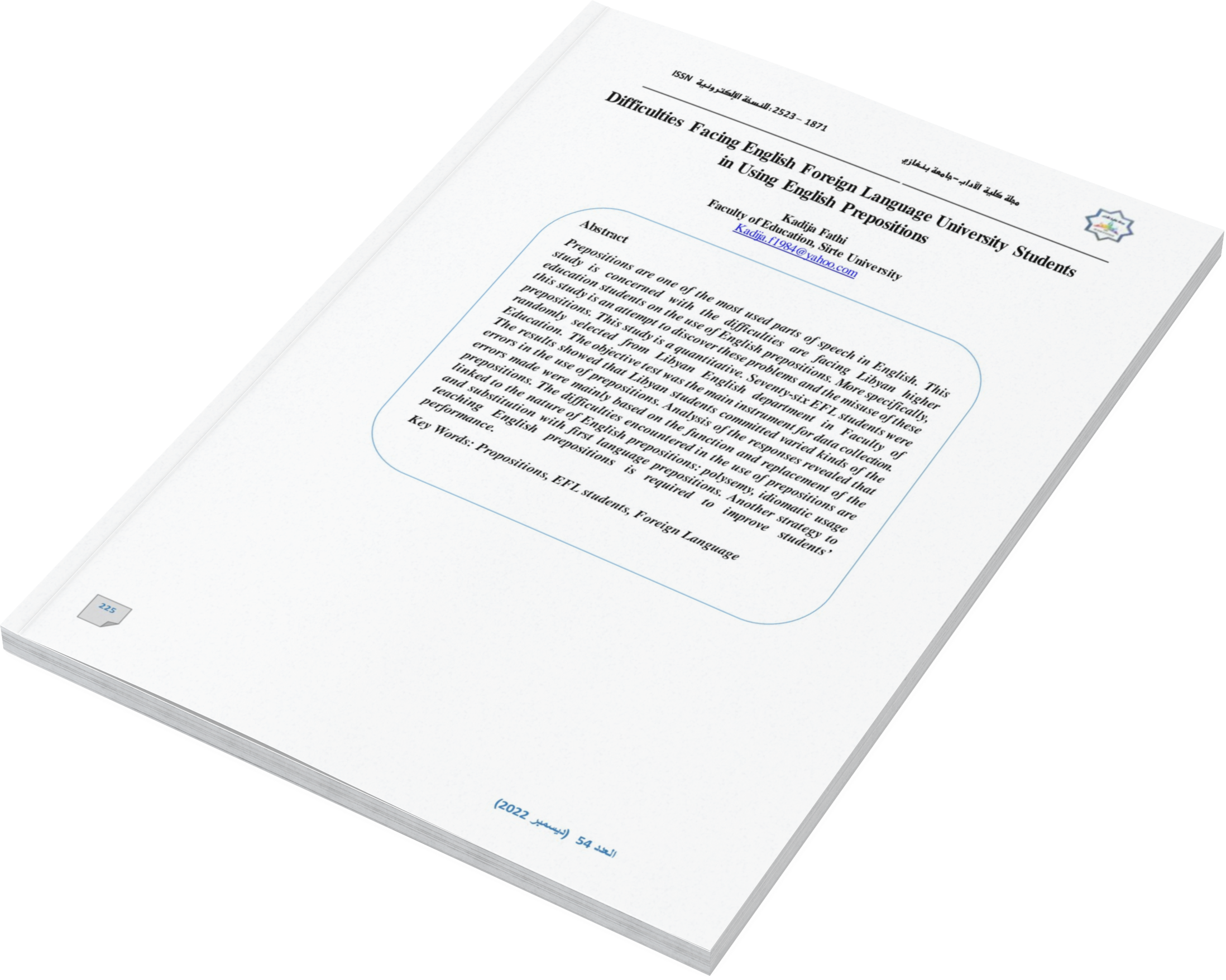Difficulties Facing English Foreign Language University Students in Using English Prepositions
DOI:
https://doi.org/10.37376/jofoa.vi54.6533Keywords:
Propositions, EFL students, Foreign LanguageAbstract
Prepositions are one of the most used parts of speech in English. This
study is concerned with the difficulties are facing Libyan higher
education students on the use of English prepositions. More specifically,
this study is an attempt to discover these problems and the misuse of these
prepositions. This study is a quantitative. Seventy-six EFL students were
randomly selected from Libyan English department in Faculty of
Education. The objective test was the main instrument for data collection.
The results showed that Libyan students committed varied kinds of the
errors in the use of prepositions. Analysis of the responses revealed that
errors made were mainly based on the function and replacement of the
prepositions. The difficulties encountered in the use of prepositions are
linked to the nature of English prepositions: polysemy, idiomatic usage
and substitution with first language prepositions. Another strategy to
teaching English prepositions is required to improve students’
performance.
Downloads
References
- Abdulkarim, H. (2008). The Communicative approach to teaching English prepositions to Arab students. Unpublished Ph. D. Thesis submitted to Aleppo University, Syria.
- Abkarian, G. G. (1983). More negative findings for positive prepositions. Journal of Child Language, 10(2), 415-429.
- Alotaibi, A., Wu, S., & Alrabah, S. (2018). Challenges in learning English prepositions by Kuwaiti EFL learners: A call for bridging the gap in Kuwait’s new English language curriculum. Advances in Social Sciences Research Journal, 25, 516-530. https://doi.org/10.14738/assrj.511.5659
- Anjayani, P., & Suprapto, S. (2016, May). Error Analysis on the Use of Prepositions in Students’ Writing (A Case Study of the Eleventh Grade Students of SMA Negeri 9 Semarang in the Academic Year of 2014/2015). In ELT Forum: Journal of English Language Teaching (Vol. 5, No. 2).
- Altakhaineh, A. M., & Ibrahim, M. K. (2019). The incidental acquisition of English prepositions by Arabic-speaking EFL learners: Evidence from Al Ain University of Science and Technology. SAGE, 9 (3), 1-10. https://doi.org/10.1177%2F2158244019861497
- Alwreikat, E. A., & Yunus, K. B. (2020). Conventional errors in employing English prepositions in the written work of EFL Jordanian students. International Journal od Academic Research in Business & Social Studies, 10(3), 488-496. https://www.researchgate.net/publication/343674321
- Cambridge learner's Dictionary. United Kingdom. (2004).
- Celce-Murcia, M., & Larsen-Freeman, D. (1999). The grammar book: An ESL/EFL teacher’s course. Heinle and Heinle.
- Conner, P. S., & Chapman, R. S. (1985). The development of locative comprehension in Spanish. Journal of Child Language, 12(1), 109-123.
- Creswell, J.W. (2013) Research Design: Qualitative, Quantitative, and Mixed Methods Approaches. 4th Edition, SAGE Publications, Inc., London.
- Durkin, K. (1981). Aspects of late language acquisition: school children's use and comprehension of prepositions. First Language, 2(4), 47-59.
- Farooq (2012). Opinion of Second Language Learners about Writing Difficulties in English Language. South Asian Studies, 27, 183-194.
https://pdfs.semanticscholar.org/951b/3442733b7e154daf2ac374e61338297f7dee.pdf
- Joe Carillo, (2009). Specific Rules for Preposition Usage.
- Kemmerer, D. (2005). The spatial and temporal meanings of English prepositions can be independently impaired. Neuropsychologia, 43, 797-806.
- Koffi, E. (2010). Applied English syntax: Foundations for word, phrase, and sentence analysis. Dubuque, Iowa: Kendall Hunt Publishing Company.
- Langendoen, D. (1975). Randolph Quirk, Sidney Greenbaum, Geoffrey Leech & Jan Svartvik, A grammar of contemporary English. London: Longman, 1972. Pp. xii 1, 120. Journal of Linguistics, 11(2), 277-280. doi:10.1017/S002222670000459X
- Larsen-Freeman, D., & Celce-Murcia, M. (2015). The grammar book: Form, meaning and use for English language teachers, (3rd). Heinle and Heinle.
- Lee, J., Seneff, S. (2007). “Automatic Generation of Cloze Items for Prepositions”. INTERSPEECH, 8th Annual Conference of the International Speech Communication Association: 2173-2176, Antwerp, Belgium.
- Leikin, M. (1998). Acquisition of locative prepositions in Russian. Journal of Psycholinguistic Research. 279(1), 91-108.
- Longman Word Wise Dictionary (2003). British.
- Lorincz, K., & Gordon, R. (2012). Difficulties in learning prepositions and possible solutions. Linguistic Portfolios, 1(1), 14.
- Mew, Y. H., & Seaton, A. (2007). Basic English Grammar for English Language Learners Book 1.
- Murcia-Celce, M., & Diane, F. L. (1999). The Grammar Book: An ESL/EFL Teacher's Course.
- Murphy Raymond (2004). English Grammar in use. Cambridge oup.
- Omar, M. (2005). Baiaan Al-Lazim wa Al- Mutaadie. Al-Turath Al-Arabi. (Vol 99-100). Arab Union. Damascus. Syria
- Quirk Randolph, Greenbaum Sidney. (1972). A university Grammar English. Asia. Radden, G. (1989). Figurative Uses of Prepositions. In: Dirven, Auser’s grammar of English: Word, sentences, text, interaction, pp.551-576.
- Shawish M. & Audeesh. S, (2000) Modern English Grammar, 1st ed. AlEzdihar, Misurata
- Thomson, A. J., & Martinet, A. V. (2009). A Practical English Grammar. Oxford: Oxford University Press.
- Takahaski, G. (1969). Perception of space and the function of certain English prepositions. Language Learning, (19), 217-234
- Tomasello, M. (1987). Learning to use prepositions: a case study. Journal of Child Language. (14), 79-98.
- Vandeloise, C. (1999). Methodology and Analysis of the Preposition in Cognitive Linguistics, 5(2), 157-184.
- Wijaya, D. (2014). ‘Applying a cognitive linguistics approach to teaching English prepositions In, On, At in the Indonesian EFL classroom’ The eleventh conference on English studies’ Jakarta, Indonesia. Plenary paper.

Downloads
Published
How to Cite
Issue
Section
License
Copyright (c) 2024 Journal of the Faculty of Arts

This work is licensed under a Creative Commons Attribution-NonCommercial-NoDerivatives 4.0 International License.




